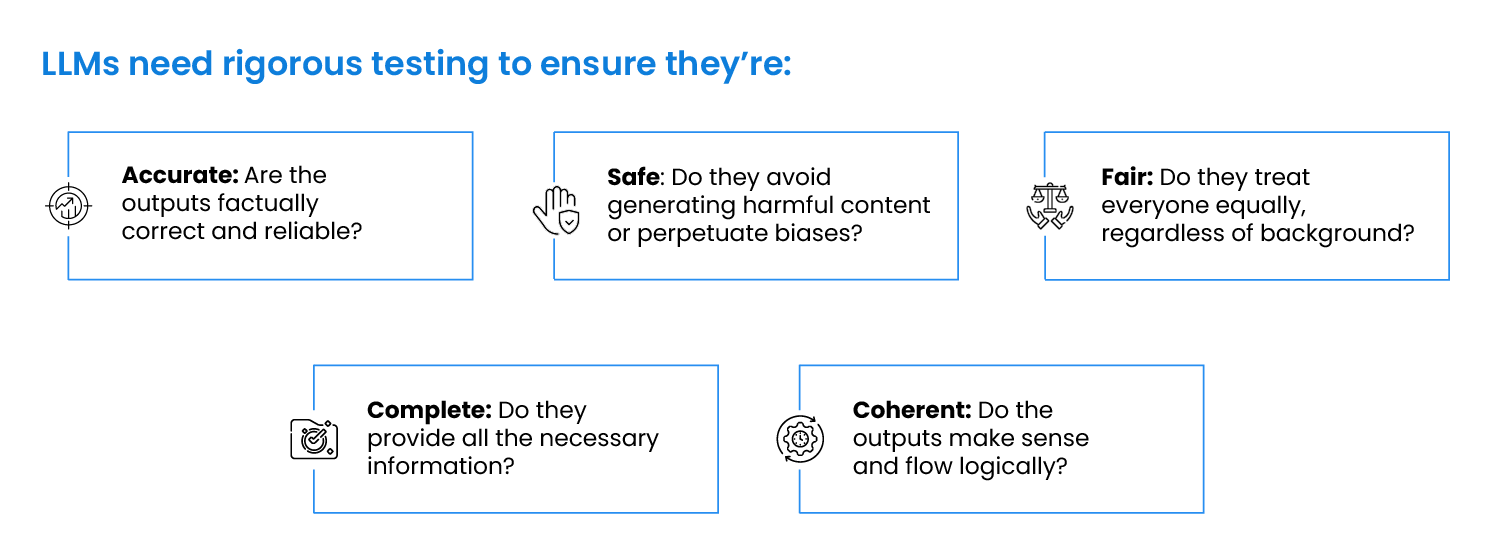- May 24, 2024
- Posted by: Abishek Balakumar
- Category: Gen AI

Let’s talk about testing Large Language Models (LLMs), these AI superstars that can write human-quality content, translate languages, and answer your questions in an informative way. They’re everywhere these days, from chatbots to creative writing assistants, and their potential seems limitless.
But here’s the thing: with great power comes great responsibility (cue Spiderman), and in the world of LLMs, that translates to making sure they work as intended and don’t go off the rails. That’s where LLM testing comes in. Imagine you built an LLM that writes product descriptions. You wouldn’t want it accidentally generating gibberish or, worse, offensive content, right?
LLM Testing helps you identify these issues before they reach your customers. Industry analysts like Gartner and Forrester predict that by 2025, 70% of organizations will be using some form of AI, and a significant portion of that will involve LLMs. So, understanding how to test them is becoming an increasingly valuable skill.
This blog will be your guide to the wild world of LLM testing. We’ll break down the different types of tests, explore the challenges you might face, and equip you with best practices to ensure your LLMs are up to snuff.
Why is LLM testing different?
Testing LLMs throws a curveball at traditional software testing methods. LLMs are inherently unpredictable, unlike your typical software application, which produces predictable outputs. They’re trained on massive datasets of text and code, and their responses can vary depending on the input and the context. Think of it like asking a friend for a restaurant recommendation. They might suggest Italian one day and Thai food the next, depending on your mood and what they recently ate.
This non-deterministic nature of LLMs makes it tricky to write tests that say, “If I ask for a summary of this article, the output should be exactly X characters long.” That exact match approach just won’t work.

Here’s a stat to consider: a McKinsey report estimates that up to 80% of the value delivered by AI comes from non-technical factors like effective human oversight and testing. So while building a powerful LLM is important, making sure it works as intended is equally crucial.
The challenges of LLM testing
Unlike traditional software testing, LLM testing comes with its own set of challenges. Firstly, their non-deterministic nature means they can produce varying outputs for the same input, complicating the creation of fixed test cases. Secondly, LLMs operate as black boxes, concealing their inner workings, which impedes efforts to identify the sources of errors. Additionally, the cost associated with testing LLMs can be significant, particularly for non-open source models where expenses rise in tandem with the number of queries used for testing. These factors collectively contribute to the complexity and expense of ensuring the reliability and accuracy of LLMs through testing procedures.
The testing toolbox: Functional, performance, and responsibility testing
Let’s delve into the different types of tests you can use for your LLM:
- Unit Testing: The foundation of LLM testing is unit tests that evaluate an LLM’s response to a specific input based on predefined criteria. Imagine testing an LLM to summarize news articles. A unit test would assess if the summary captures the main points and avoids factual errors.
- Functional Testing: This involves evaluating an LLM’s performance on a particular task, like text summarization or code generation. It essentially groups multiple unit tests to assess the LLM’s proficiency across a specific use case.
- Regression Testing: As you iterate and refine your LLM, regression testing ensures that changes haven’t introduced any unintended consequences. It involves running the same set of tests on different versions of the LLM to identify potential regressions.
- Performance Testing: Here, the focus isn’t on the correctness of the output but rather on the LLM’s efficiency. This includes metrics like tokens processed per second (inference speed) and cost per token (inference cost). Optimizing performance is crucial for cost-effectiveness and real-time responsiveness.
- Responsibility Testing: This ensures your LLM adheres to ethical principles and avoids generating biased or offensive content. Bias metrics and toxicity metrics can be used to identify and mitigate these issues.
Metrics for measuring LLM performance
Various metrics are used to measure LLM performance during testing. Some of the common ones include:

Frameworks, metrics, and automation: Best practices for LLM testing
Now that you understand the different types of tests, let’s explore some best practices to ensure your LLM testing is effective:
Frameworks like DeepEval offer a suite of tools and metrics specifically designed for LLM testing. These tools can streamline testing and provide valuable insights into your LLM’s performance. Choosing the right evaluation metrics is crucial. Traditional metrics like BLEU score, which focuses on n-gram overlap, might not be ideal for complex tasks like summarization. Consider using more sophisticated metrics like G-Eval or QAG that evaluate semantic similarity and factual correctness. Integration with CI/CD pipelines allows you to automate your LLM tests, ensuring they are run every time you make a change to the model. This helps catch regressions early and prevents bugs from slipping into production.
Test your LLM with data that reflects real-world scenarios. This helps identify potential issues that might not surface with synthetic data sets. While automation is essential, human judgment remains invaluable. Involving human evaluators can help assess aspects like coherence, readability, and overall user experience.
Energy shots! The future of LLM testing
We’re not revisiting the challenges here. I’m simply emphasizing the importance and the opportunities!
| Challenges | Opportunities |
| The Moving Target: LLMs are constantly being updated and improved, requiring adaptable testing suites. | Advanced Techniques: New techniques like adversarial testing can identify vulnerabilities and edge cases. |
| Standardization: The lack of standardized benchmarks and metrics makes it difficult to compare LLM performance. | Explainable AI (XAI): Advancements in XAI can improve LLM interpretability and debugging. |
| Explainability: Difficulty in understanding the reasoning behind LLM outputs hinders error and bias identification. | Human-AI Collaboration: Collaboration between humans and AI can enhance test design, interpretation, and automation. |
LLM testing is a critical step towards ensuring these powerful models’ responsible and ethical deployment. By employing a multi-layered testing approach, leveraging the right tools, and staying informed about emerging trends, we can build trust in LLMs and unlock their full potential to revolutionize various industries.
Is there anything specific you’d like to delve deeper into regarding LLM testing? I can provide more details on a particular testing approach or explore the ethical considerations surrounding LLM development.
